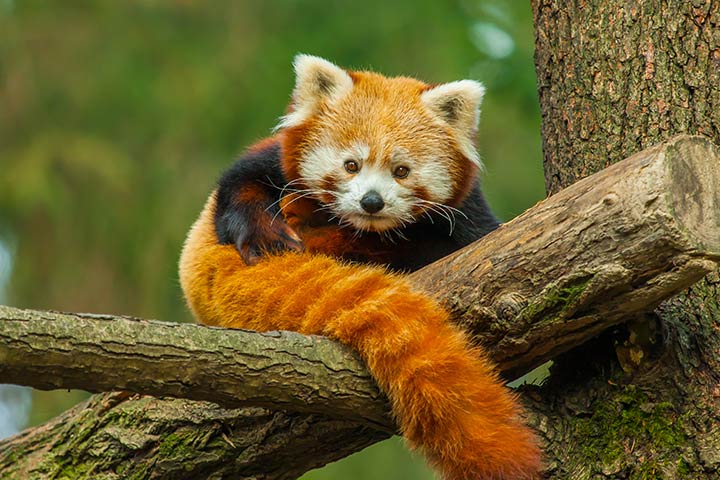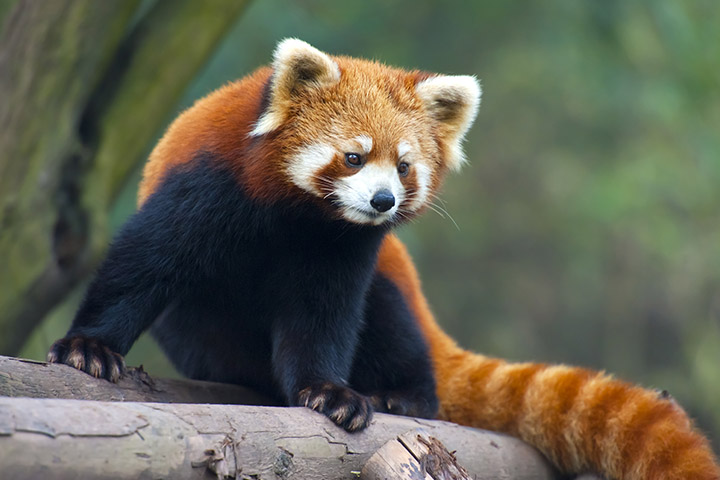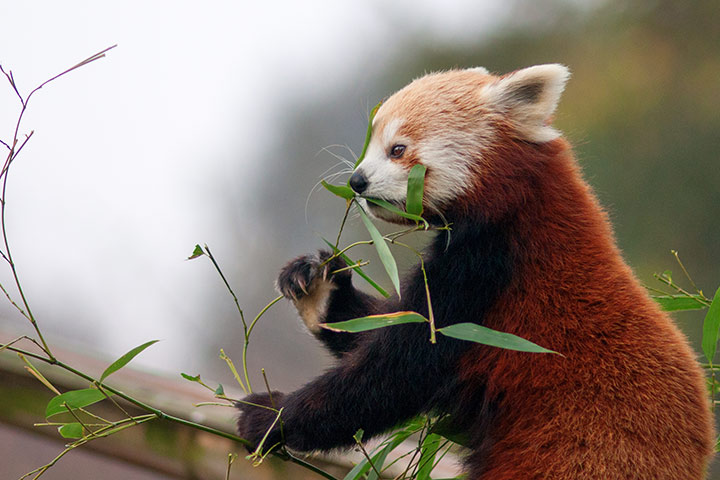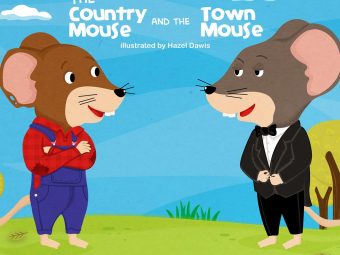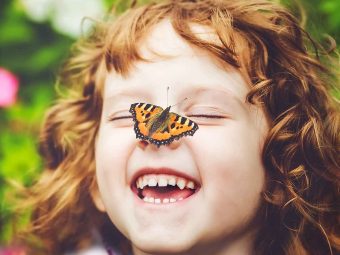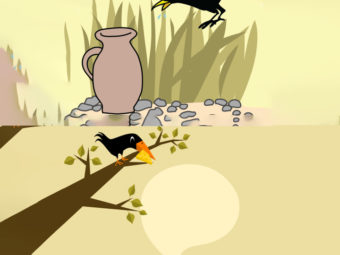
Image: ShutterStock
Red pandas are soft and cuddly mammals that look like teddy bears. They are gentle creatures that show friendly behavior and live high in the trees, feed on bamboo, and pretty much chill most of the time. In this post, we provide you with intriguing red panda facts for kids, including information on their lives, habitat, and food habits.
Unfortunately, the cute species has recently been threatened with extinction because of human encroachment on their habitat. Hence, we must educate our children about red pandas and prevent them from going extinct.
Quick Facts About The Red Panda
Scientific name:Ailurus fulgens
Size:Body is 22 – 24.6 inches (56 – 62.5 centimeters) long. The tail is about 14.6 – 18.6 inches (37 to 47.2 centimeters)
Weight:Males, 8.8-13.3 pounds (4 – 6.5 kilograms); Females, 6.6-13.2 pounds (3-6 kilograms)
Lifespan:8 years in the wild; Can reach 14 years of age in captivity
`
IUCN conservation status:Endangered
Name & Taxonomy
- The name panda comes from theNepali word called “poonya,”which meansbamboo eater.
- The red panda isnot related to the giant pandabut is more closely related to a raccoon.
- Before the discovery of the giant panda, the red panda wassimply called panda. It was known to theWestern worldway before the black and white giant panda came into the limelight.
- Red pandaswere once consideredto be of thebearfamily. However, extensive DNA analysis found that they belong to a family of their own.
- They are theonly living membersof their biological family calledAiluridae. All other members of the family are extinct.
- There aretwo subspeciesof the red panda:fulgensandstyani.Pandas of the styani subspecies are usually larger and with deeper fur color when compared to fulgens subspecies.
- Red panda goes by other several English names, the most popular ones beingfirefox,firecat, andred cat. Some scientific researchers from the field of zoology also refer to the animal as the lesser panda.
- a catsince the size ofthe animalis quite similar to that of a domestic cat.
Lifespan
- The red panda has an average lifespan of eight years, although those living in captivity may live up to 14 years.
- In rare instances, captive red pandasmay live up to 23 years.
Appearance
- The body of an adult panda (except the tail) usually stands at22 – 24.6 inches (56 – 62.5 centimeters). Interestingly, theirtailalone can measure at14.6 – 18.6 inches (37 to 47.2 centimeters).
- Thewrist boneextends to create afalse thumb, which allows the animal to have an optimum grip. Red panda股票the extended wrist bone feature withthe giant panda.
- Thefuron the back and above the limbs isreddish brown.The fur on the limbs and belly isblack.
- Anadult male red pandacan weigh about8.8-13.3 pounds (4 – 6.5 kilograms). Femalesweigh between6.6-13.2 pounds (3-6 kilograms).
- Red pandas havefurry feet.It helps them have abetter gripwhen walking in snow.
- Cubs覆盖着皮毛和吗almost blindwith their eyes closed at birth. A single cub weighs about3 – 4 ounces (approx. 90 to 110 grams).
- They havesharp clawsalmost resembling that of a cat. The red panda’s claws help itgrip the barkofthe treewhile climbing.
- Claws are semi-retractile, which means the animal can partially withdraw within the paw.
Habits & Lifestyle
- The red panda uses thetail to wrap itselfwhen the weather is cold. The tail makes a greatblanket when it is snowing.It explains why they have such long, bushy tails.
- The long tail of the animal also has another functional benefit: it helps the animalbalance its weight when walkingon narrow tree branches.
- They aremostly nocturnal.They may also forage for food during dusk and dawn.
- Red pandas show most activity duringcolder weatherand tend to become lethargic when the weather gets warm.
- Red pandas spend the majority of their time ontree topsand thus arearboreal animals.
- The Red panda ismostly solitaryexcept duringmating season.
- It isless commonto see red pandas livein pairsandrareto see them stayin family groups.
- It is aquiet animaland has very few vocalizations such astwitterandsqueal. Sometimes they mayhissorgrunt. Cubswhistleorbleatoften to call their mother.
- Just like a dog, red pandaspant during warm weatherto cool their bodies and regulate their body temperature.
- Male red pandasfight while standing on their hind legsand strike each other with their claws.
Reproduction
- Female red pandas have a gestation period of 130 days (about four months and ten days).
- Red pandas do not stay in pairs, andonly females raise the cubs.
- The female makes anest in tree stumps, tree holesorbamboo thicketsbefore giving birth to the cubs. Nests are usually lined with leaves or moss.
Diet
- The main food of the red panda is bamboo branches.It also eats fruit, insects, small reptiles, and bird eggs sometimes.
- Bamboo makes85-90%of aRed panda’s diet.They prefer the leaves and shoots of the plant.
- Although they spend most of the time on trees, they may descend to the ground todig out roots and grass to eatwhen they are very hungry.
- A red panda is heavily dependent on its habitat for food andmay not migrate to other areasto look for extra food, unlike other animals. It makes the animalvery sensitiveto any habitat destruction.
- Red pandasavoid water.They get most of their water intake from their solid diet.
栖息地和危害
- A single red panda will command a forest area ofone square mile, which is their territory.
- Red panda’s natural habitat spreads across five countries namely China, India, Nepal, Burma, and Bhutan.
- In their natural habitat, thetop predatoror threat to a red panda is the/4/
- Red pandas prefer colder climates anddo not liketemperaturesabove 25°C (77°F).
- At any sign of danger, the red panda willscurry up the nearest tree.If cornered, a red panda will stand on its hind legs anddefenditself with itssharp pawsand teeth.
- Less than 10,000 red pandas在野生动物,它们的数量正在慢慢declining.
- The red panda is at risk ofpoachingand losing its habitat due todeforestation. The International Union for Conservation of Nature (IUCN) declared thered pandaas anendangered animalin the year 2008.
- About70%of red panda habitatfalls outside government protected areas,which makes conservation of the animal even more essential.
- Red pandas that live in captivity undergo somebasic trainingto help theminteract with human beings.However, if they show nointerest in training, then the panda is not trained forcefully.
Red Panda In Society & Culture
- A company called Mozilla chose the red panda as the software icon for itsinternet browser called Firefox,which is another name for the Red panda.
- In the popular animated filmKung FuPanda, thecharacter of Shifu, who is the Kung Fu teacher, is a Red panda.
- Every year, the Indian state of Sikkim organizes a music event called theRed Panda Festival. The red panda is thestate animal of Sikkim.
- Every year, the international community of conversationalists picks a date inSeptemberas the InternationalRed Panda Day.Various zoos and natural history organizations conduct conservation programs with conservation efforts in mind on this day to spread awareness about red panda conservation.
- Although pandas are perceived as gentle and cute animals, the red pandacannot be domesticated. These pandas are wild animals and under no circumstance can they become pets.
Frequently Asked Questions
1. What are baby red pandas called?
Baby red pandas are called cubs, just like the offsprings of their black-and-white namesake, the giant panda.
2. How long do red pandas sleep?
Red pandas sleep for long hours during the day, usually perched in a tree with their bushy tail wrapped around them for warmth. They are usually solitary creatures and become active at night.
3. Do red pandas cry?
A red panda has a distinctive cry because of which it is also known as Wah (4). However, these animals are generally quiet. They mostly tweet and whistle to communicate.
4. Do red pandas glow in the dark?
Red pandas do not glow in the dark in the usual sense of the word. But the white areas on their faces appear to be luminescent. So, when it’s dark, this characteristic can guide lost cubs back to their mothers (5).
5. Do red pandas get angry?
Aggression is not a typical trait of red pandas. But when they do, they arch their backs and tails. They also shake their head sideways, stand on their hind legs, and bat at their opponents with paws (6).
6. Do red pandas swim?
Yes. Red pandas are exceptional swimmers, but they seldom engage in this activity (4).
7. What is a group of red pandas called?
A group of red pandas is called a pack, but they are mostly seen alone except during mating season.
Red pandas are fluffy, cuddly animals that look like teddy bears and live high up in the trees. They are presently listed as an endangered species since humans have destroyed their natural habitat. Therefore, provide all-round education to your children with some fascinating red panda animal facts and inspire them to contribute toward protecting these animals from extinction. If your child has an affinity for learning about nature and different animals, they will surely be amused by this peculiar creature and these interesting facts about its lifestyle, appearance, and more.
Infographic: Protecting The Red Panda
The red panda species have become endangered due to various human activities; however, protecting them from extinction is important to maintain a balance of flora and fauna on the planet. This infographic highlights the reasons for protecting the red panda, things you can do, and steps a few organizations are taking in this direction.

Illustration: Momjunction Design Team
Get high-quality PDF version by clicking below.
Download Infographic
Key Pointers
- Red pandas belong to a unique biological family with no other living members.
- They can live up to 14 years in captivity, but the average lifespan is around eight years, while rare cases show they may live up to 23 years.
- Being nocturnal animals, they wrap their bushy tails around themselves to keep warm, and their long tails help them balance while walking on narrow branches.
- Female red pandas give birth to three to four cubs during spring and summer, with a gestation period of 130 days.
- Bamboo branches make up to 85% of their diet, and they also consume fruits, insects, small reptiles, and bird eggs.
References:
- Yibo Hu et al.; (2020); Genomic evidence for two phylogenetic species and long-term population bottlenecks in red pandas; Science Advances.
https://www.science.org/doi/10.1126/sciadv.aax5751 - Red Panda; Smithsonian’s National Zoo & Conservation Biology Institute.
https://nationalzoo.si.edu/animals/red-panda - Red Panda; San Diego Zoo Wildlife Alliance.
https://animals.sandiegozoo.org/animals/red-panda - Red Panda; Animalcorner.org
https://animalcorner.org/animals/red-panda/ - 15 fantastic facts about red pandas; redpandanetwork.org
https://redpandanetwork.org/post/15-Fantastic-Facts-about-Red-Pandas#:~:text=Red%20Pandas%20Glow%20in%20the - Red Panda; Brandywinezoo.org
https://brandywinezoo.org/animals/red-panda/#:~:text=Aggression%20is%20rare%2C%20but%20angry - How to care for red pandas; Smithsonian’s Nationa Zoo and Conservation Biology Institute
https://nationalzoo.si.edu/animals/news/how-care-for-red-pandas#:~:text=Although%20red%20pandas%20are%20excellent


